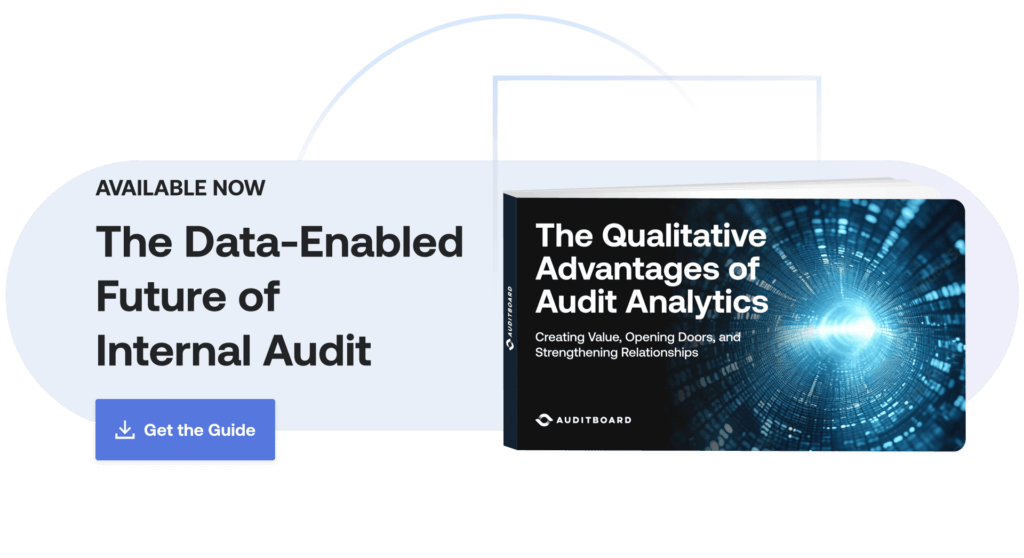
March 1, 2024 • 6 min read
Winning the Talent War With Audit Analytics Technology


Scott Madenburg & Trent Russell
In the war for top talent, organizations must find new ways to differentiate themselves against the competition. The use of next-generation technologies like audit analytics can yield a crucial advantage. In this article, we’ll dive into why and how audit analytics technology is becoming an important competitive advantage in the quest to attract and retain top-quality internal audit talent.
To learn more, download The Qualitative Advantages of Audit Analytics: Creating Value, Opening Doors, and Strengthening Relationships.
The Internal Audit Foundation’s 2024 Risk in Focus North America report (sponsored by AuditBoard) found that 65% of internal audit leaders identified human capital as a top-five risk facing their overall organizations. Leaders also face big challenges within internal audit: According to The IIA’s 2023 Pulse of Internal Audit report, the top three primary recruiting challenges for U.S. internal audit departments were compensation expectations (64%), too few applicants (51%), and competition from other organizations (49%).
Internal audit is indeed drawing from a shrinking applicant pool. Beyond the high number of baby boomers retiring from accounting, the number of people joining the profession has declined in recent years. The AICPA’s 2023 Trends report indicated that, following a steady decline of 1-3% since the 2015-2016 academic year, bachelor’s degree completions in accounting dropped 7.8% in 2021-2022 from prior-year figures. Though enrollment predictions for 2023 were optimistic, only time will tell whether students complete their degrees.
A 2023 Wall Street Journal article examined how this deepening accountant shortage is impacting both the profession and the roles it serves, including how it could imperil auditors’ central role in ensuring trust in the capital markets. Students and accountants, however, point to deterrents such as low salaries (especially compared to technology and finance), demanding workloads, mundane tasks, pervasive burnout, and a lack of meaningful work.
To address the shortage, many internal audit functions are reimagining their approach to recruiting and retention, including looking to nontraditional sources for new auditors. They must also invest in efforts to make day-to-day work more efficient, engaging, and meaningful, and analytics are essential in answering that need. Below, we explore in more depth why and how analytics can be a differentiator in the struggle to find, keep, and accelerate the development of top talent.
Technology’s Role in Attracting and Retaining Top Talent
Technology investments offer a clear advantage in recruiting candidates at every level. Whether you’re hiring a new chief audit executive (CAE) or an entry-level internal auditor, every candidate wants to ensure their role will enable them to continue enriching their skills and experience. Most professionals view technology as an increasingly significant avenue for development, reflecting a big-picture reality in the working world overall: In the World Economic Forum’s Future of Jobs Report 2023, 67.7% of respondents selected “technological literacy” as a skill that will grow in importance over the next five years, making it the #3-ranking choice overall. (Creative thinking and analytical thinking were #1 and #2, respectively.)
The brightest internal audit professionals seek the opportunity to learn valuable skills that can help them advance their careers in the short and long term. The opportunity to use next-generation technologies like audit analytics can help entice top talent to join and stick around. For young hires in particular — for whom technology use is second nature — a lack of technology investment can be an immediate red flag. We also know seasoned CAEs who will leave their positions if their organizations aren’t investing in technology. When assessing new roles, these CAEs ask detailed questions about the tools being used, technology budgets, and planned investments. A lack of willingness to invest in technology reads as a lack of willingness to invest in improving processes and developing employees. Conversely, technology investments are a nontrivial way smaller audit departments can differentiate themselves against larger firms.
Welcome to the new reality: A lack of investment in next-generation technologies (e.g., advanced analytics, AI, ML, process mining, automation) will cause top talent to decline job offers or leave roles. After all, you’re making their jobs more difficult and less enjoyable by using antiquated tools, and you’re not serving their professional development or their résumés.
Internal audit has an important opportunity to help organizations understand and realize analytics’ key qualitative benefits in the areas of human capital, cross-departmental collaboration and relationship building, stakeholder engagement and partnership, and risk management awareness. Attracting top-tier talent is an important step in that direction.
About the authors

Scott Madenburg, CIA, CISA, CRMA, is the founder of ARCHybrid, where he serves as a market advisor, consultant, and trainer, guiding organizations and professionals in transforming their audit, risk, and compliance functions to enhance efficiency, strengthen controls, and address emerging threats. Connect with Scott on LinkedIn.

Trent Russell is the Founder of Greenskies Analytics, where he develops audit analytics strategies, helps Internal Audit teams launch their data analytics initiatives, makes the analytics initiatives actually work, and moves Internal Audit teams up the analytics maturity model. In addition to serving his clients, Trent also hosts The Audit Podcast and facilitates quarterly audit analytics roundtables. Connect with Trent on LinkedIn.
You may also like to read


Top headlines that defined 2025 for internal auditors

Master your audit playbook: essential steps for internal audit teams

How the C-suite views risks and opportunities in 2026: are internal auditors poised to help?

Top headlines that defined 2025 for internal auditors

Master your audit playbook: essential steps for internal audit teams
Discover why industry leaders choose AuditBoard
SCHEDULE A DEMO




